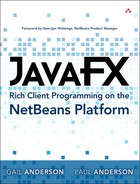Contents
Chapter 1 A Tour of the NetBeans Platform
1.2 The NetBeans Platform: The Big Picture
1.3 FamilyTreeApp Reference Application
JavaFX 3D Integration Possibilities
1.5 How to Get Java and the NetBeans Platform Software
Coarse-Grained Notification for JavaBean Objects
Lambda Expressions with Functional Interfaces
Event Handlers and Loose Coupling
2.4 Improving the User Experience
2.5 Concurrency and Thread Safety
Adding Listeners and Thread Safety
Chapter 3 Introduction to JavaFX
Creating a JavaFX FXML Application
Using Listeners with Observable Properties
4.1 Creating JavaFX Properties
JavaFX Properties with Lazy Evaluation
Methods equals() and hashCode()
4.2 Using JavaFX Properties in a JavaFX Application
Creating a JavaFX FXML Application
4.5 Concurrency and Thread Safety
Observable Properties and Thread Safety
4.7 Monitoring Background Tasks
Updating a Read-Only JavaFX Property
Updating the JavaFX Scene Graph from a Background Task
Chapter 5 A Taste of Modularity
5.2 Creating a NetBeans Platform Application
5.4 Configuring a Module with Public Packages
5.5 Registering a Service Provider
5.6 Configuring a Window for Selection
Porting Swing UI Code to a TopComponent
5.7 Configuring a Window with Form Editing
5.8 Module Life Cycle Annotations
6.1 JavaFX and the NetBeans Platform
Java 8 and JavaFX 8 Enhancements
Create a NetBeans Platform Application
Add JavaFX Content to the TopComponent
Accessing the JavaFX Controller Instance
6.3 Integrating with the NetBeans Platform
Create a NetBeans Platform Application
Create NetBeans Platform Modules
Configure a Module with Public Packages
Configure a Window with JavaFX for Selection
Configure a Window with JavaFX for Form Editing
Chapter 7 Nodes and Explorer Views
7.1 The NetBeans Model View Controller
NodeListener and PropertyChangeListener
Creating Your Own Property Sheet
7.4 Creating a Selection History Feature
Add Features to Your Application
Chapter 8 NetBeans Platform Window System
Limiting the Window System’s Behavior
Window Header Animated Notifications
8.4 TopComponent Client Properties
8.5 Creating Non-Singleton TopComponents
Opening Windows from User Code
8.6 Window System Life Cycle Management
RoleExample Application and Role-Based TopComponents
Credential Checking and Role Assignments
9.3 Editing the Node Hierarchy
Implementing Cut, Copy, Paste, Delete
9.4 Inter-Window Drag and Drop
Implementing Drag and Drop Delete
Chapter 10 Building a CRUD Application
10.1 Create-Read-Update-Delete Application
10.2 Using CRUD with a Database
10.3 Concurrency in the FamilyTreeApp Application
Concurrency with Delete and Create
11.3 Customizing Standard Dialogs
Coordinating Input with Other Panel Wizards
Prepare to Use the Validation Library
Using the Simple Validation API Library
Building the Dynamic Step Wizard
12.9 Wizard Instantiating Iterators
13.2 The File System API Overview
Get or Create a File in a Folder
File System API Useful Methods
Implementing the FileChangeListener
13.4 Including a File with Your Application
Using the InstalledFileLocator Service
Installing an NBM in NetBeans IDE
13.5 The Layer File and System FileSystem
Exploring the System FileSystem
Using the Layer File for Inter-Module Communication
FileObject, DataObject, and Node
FileObject MIME Type and Lookup
DataObject Factory and DataObject Lookup
Accessing FileObjects from DataObjects
Create and Edit a New FTR File
Provide Child Nodes Based on Content
14.3 Working with MultiView Windows
14.4 Creating an XML-Based File Type
15.1 JavaFX Charts and the NetBeans Platform
Working with AbstractTableModel
15.2 Introducing JavaFX Charts
15.3 Data Visualization with JavaFX Charts
15.4 Adding Behaviors to JavaFX Charts
16.1 RESTful Web Services and the NetBeans Platform
16.2 Creating RESTful Web Services
Create RESTful Web Service Application
RESTful Services from Database
Entity Classes and JavaFX Properties
16.3 A Java Application Web Service Client
16.4 RESTful Web Services in a NetBeans Platform Application
Generate RESTful Web Service Clients
Implementing a RESTful Client Service Provider
Chapter 17 Branding, Distribution, and Internationalization
Customizing the Application Title
Enable Updates of Your Application
Dynamically Uninstall a Module (Plugin)
Adding Modules to an Application
Customizing the Installer Images
17.4 Application Internationalization
Internationalization and the NetBeans Platform
Internationalization and JavaFX
